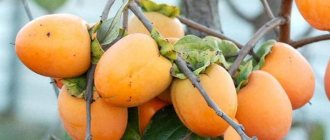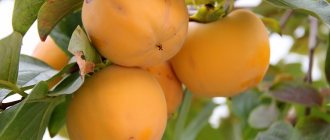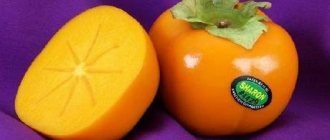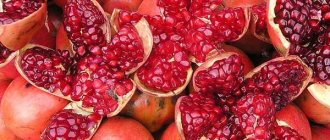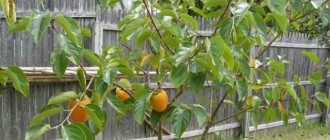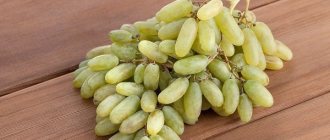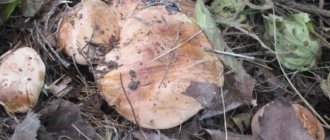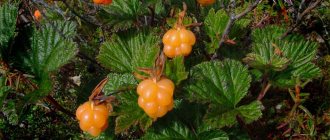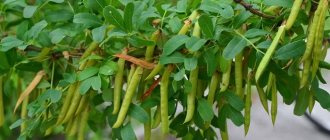Description of the plant
Persimmon is a long-liver in the plant world. Even medium-sized shrubs can be very old, having lived for several hundred years. Large trees live for about five hundred years.
The number of cultivated persimmon species exceeds two hundred varieties. There are both seedless and seed varieties of persimmon. Both the plants themselves and their fruits have a wide variety of forms. South American varieties have the largest fruits. The size of their fruits can reach 900 g; These are large and sweet berries with a dark brown, “chocolate” color. In the Caucasus and Greece, persimmons with small fruits weighing no more than 40 g are cultivated. The “Sharon” variety, which has no seeds and a very low tannin content compared to other varieties, is widespread in the Mediterranean.
Eastern persimmon during harvest
A separate group is represented by the so-called “kings”. The fruits of the kinglets are formed differently depending on how pollination occurred: they acquire an astringent taste and a bright orange color if pollination has not occurred, and a brownish tint and a sweet taste if pollination has occurred.
The fruits of almost all varieties of persimmon have a distinctive property: despite their fairly high sugar content (more than 25%), they do not lead to an increase in its level in the blood. That is why persimmon is recommended to be used as maintenance therapy for many diseases.
Plant during the growing season
The height of the plant, depending on the variety, can vary widely (bushes - up to 5 m, trees - up to 15 m). Persimmon is not an evergreen tree - its foliage is renewed once a year, although the period of “leafless” existence of the plant is relatively short. The leaves have an oval shape, pointed at the end. They are shiny on top and matte on the bottom. In autumn, about two months before they fall, they turn bright red. Most persimmon species are capable of self-pollination, however, monoecious plants are also found.
King fruits with successful pollination
Persimmon fruits range from 2 to 15 cm in diameter. The fruits remain hanging on the trees after the leaves have completely fallen off, since their ripening occurs somewhat later. By the time they ripen, their skin turns yellowish-red. The color shades of the pulp can be very diverse. The pulp of a fully ripened persimmon has a slimy or jelly-like consistency. The fruit contains from 3 to 10 large seeds; in some species, seeds may be absent. The yield is about 60-120 kg from a medium-sized tree. The fruit ripening time occurs in autumn: depending on the variety, it can occur from September to November.
Foliage of the plant in early autumn. Noticeable partial change in leaf color
In addition to sugar, the fruit contains a large amount of ascorbic acid (vitamin C) and tannins (tannin). Due to their properties, the fruits are used for the needs of the confectionery industry and pharmacology.
Large persimmon type Korolka
This variety of persimmon is similar to the above-mentioned Korolek , but the difference is that the fruits of this persimmon are much larger, the flesh is less brown, and when this persimmon is unripe, it knits a little, but when fully ripe, not a trace remains of the viscosity. If Korolka has a more chocolatey taste and the color is mostly brown with yellow tints, then this persimmon is red-brown with nutty notes in the taste. Divinely delicious!
Planting in open ground
General issues
Planting persimmons should begin with choosing a plant variety, and in this matter it is necessary to take into account a number of factors. The first is, naturally, its frost resistance. It is necessary to choose varieties that are not only able to withstand winter in the chosen climate, but also manage to form fruits in a relatively short summer and bring them to full ripening.
However, there is another important circumstance that depends on the chosen plant variety. The fact is that persimmon produces three types of flowers: female, male and bisexual. Among all varieties of persimmon, the latter are relatively rare. Why is such attention paid to this issue? The fact is that pollination in most persimmon varieties (and in some persimmon persimmons) greatly affects the quality of the fruit, its consistency and taste in general.
Variety "Sharon". A rare case of tasty fruits without seeds
Persimmon fruits that contain seeds are always more tasty than those that do not contain seeds. Sometimes you can even notice this in the example of a fruit in which, for some reason, out of all the seeds, only 2 or 3 are developed. The pulp that envelops the seeds is softer and tastier than that in which there are no seeds. In addition, it has been noticed that in fruits in which the seeds have not yet ripened, the color (and taste) of the pulp remains unchanged, and only after the seeds have formed and grown completely, the pulp begins to darken and improve its taste.
It is also believed that not only the quality of the fruits, but their quantity, that is, the productivity of the plant, depends on successful pollination. Therefore, to obtain a good harvest with high-quality fruits, it is necessary for most varieties to pollinate female flowers with male ones. In this regard, the planting of persimmon trees should be planned in such a way that for every 8-10 trees with female flowers there is one pollinator plant (which has male flowers or flowers of both sexes).
If this is not possible, or there is no desire to plant a whole garden of these trees, limiting yourself to just one, there is a special technique for processing flowers to fertilize them.
In order to pollinate a single female plant, special substances are used - gibberellins. These are special plant hormones that affect numerous processes in them. For persimmons, aqueous solutions of gibberellins are used to form seeds from the genetic material of only the female sex of the plant. Its concentration will have to be selected manually, but given the large number of flowers on persimmons, already next year it will be possible to determine exactly what concentration is needed for successful fruit set.
Choosing a landing site
After choosing the plant variety, as well as the type of pollination, you should proceed to choosing a planting site. In the case of both individual and collective planting, the following rule must be followed: each plant requires from 25 to 65 square meters. m (respectively, squares 5x5 or 8x8 m) of area for normal growth and fruiting. The specific area depends on the growth of the plant and the degree of its spreading. These are quite large areas, however, as the persimmon trees grow, the space between them can be filled with columnar varieties of plants such as apple trees or peaches.
The best soil for persimmons is loam and sandy loam of medium or high fertility. However, you should not choose a site for planting with a groundwater level higher than 75-100 cm from the surface, since most of the plant’s root system is located at a depth of up to 100 cm.
Persimmon tree garden
The area for planting trees must be well lit, since even in partial shade, persimmon leaves become deformed, shoots bend, and fruits may fall off.
A mandatory requirement is also to protect the planting site from winds, especially in winter. Sometimes all kinds of artificial hedges are used for these purposes, sometimes the area for planting persimmons is placed behind a natural or artificial obstacle, focusing on the seasonal wind rose. In any case, it should be remembered that the height of the fence should be sufficient to protect the tree trunk, since branches and shoots are more resistant to frost.
In northern conditions, persimmons are often grown using the wall-forming method. In this case, trees are planted very close to the southern wall of buildings. The building must be heated, but the wall near which the plant sits should not be insulated. Sometimes persimmons are grown in a creeping form, forming a crown in such a way that it is literally attached to the wall, like vines or ivy.
Selection of seedlings
It is best to purchase seedlings from trusted suppliers, since there is a guarantee that the exact variety that interests the gardener will be purchased. For persimmon, this is especially critical, because if you come across a variety that is not winter-hardy, the plant will simply die.
Persimmon seedlings are usually sold with a small lump of soil. If seedlings with an open root system are purchased, they should be purchased only in the fall. Moreover, it is desirable that such a root system be in the dug-out state for as little time as possible, that is, the plant must be planted as quickly as possible after digging its root system out of the ground.
Sapling with a lump of earth
When purchasing such seedlings, you should make sure that they have thin branched parts of the root system left (they are lighter in color and, if they are too dry or waterlogged, they can die literally within a few hours). However, you should not despair, since even with damaged fibrous roots the plant will be able to take root, but next year its growing season will begin several months later. Sometimes the delay in development in case of damage to the root system reaches 3-4 months and the formation of leaves begins only in July.
It is advisable to plant the plant in the fall, and the sooner the better. If the moment of planting is missed and frosts are expected in the near future, it should be postponed until spring. In this case, the seedling with a lump of earth should be kept in conditions of moderate humidity, lack of lighting and temperature +8-10°C. Planting a plant with an open root system should definitely be done in the fall.
Planting seedlings in the ground
When planting persimmons, it is mandatory to use some kind of support; this can be an ordinary support stake up to 1.5 m high. If the seedling is grafted, it should be positioned so that the grafting site is buried no more than 10 cm below the soil level.
Young persimmon seedling with support stake
Holes for planting plants must be prepared in advance. Moreover, if planting is carried out in the spring, the hole should be prepared in the fall. During the winter, not only will the fertilizing be compacted in it, but many pests and pathogens that have decided to overwinter at the planting site will also die.
If the planting is in autumn, the hole should be prepared from a month to two weeks before planting.
The hole itself has a depth of up to 60 cm and a diameter of 50-60 cm. After it is dug, it is necessary to add fertilizer to it. The composition of the fertilizer may be as follows:
- rotted manure – 10 kg
- leaf soil - 10 kg
- superphosphate – 0.3 kg
They must be thoroughly mixed and poured into the bottom of the planting hole in the form of a conical mound. The top of the mound should be “sprinkled” with a layer of garden soil about 4-5 cm thick. After winter, the mound may sag, so it should be updated a little.
The seedling itself is placed on top of the mound and carefully sprinkled with garden soil. If the grafting site or the root collar is not at the proper level (about 10 cm below ground level), you should either fill the mound or, conversely, reduce its height.
After digging the seedling, you should compact the soil tightly with a shovel, tie the seedling to a peg and water it. Watering is carried out with 20 liters of water.
There is an alternative planting method . In this case, a mound is not formed in the planting hole, and the nutrient mixture is simply laid on the bottom in an even layer, but then it is still sprinkled with 4-5 cm of garden soil.
When planting in this way, the seedling is placed not in the center of the planting hole, but near its wall, while the roots are evenly distributed over the area of the bottom of the hole and sprinkled with soil.
Once the hole is completely filled, it compacts very easily. Watering is carried out approximately half an hour after planting. This method allows you to preserve the fibrous root system of the plant and avoid injury to small branched roots.
Activities after landing
2-3 days after planting, the plant trunk should be earthed up to a height of about 50 cm. In addition, no matter the planting time, the young plant must be insulated during the first 2-3 winters. For this purpose, the seedling is placed in a special box, which is covered with insulation for the winter. Any heat-insulating material (for example, sawdust) can be used as insulation. As a last resort, you can use ordinary garden soil.
When the plant has grown sufficiently, only the central trunk and main branches should be insulated.
Persimmon at the age of 4 years
It would also be a good idea to mulch the soil for the winter with any available material. The mulch is laid at a distance of about 50-70 cm from the tree in a layer of 5 to 10 cm.
With the right approach to cultivation, the plant produces its first fruits within 3-4 years. However, you shouldn’t get too carried away and try to “drive out” the persimmon, especially since its life cycle is very long. It is better to devote the first years to such an important event as the formation of a tree crown. In the absence of normal pruning, the fruiting areas will be located higher and higher, which will lead to branches breaking off and a deterioration in the appearance of the tree.
For persimmons, the so-called “modified leader” form of pruning is recommended. In this case, the distances between skeletal branches in the crown range from 20 to 40 cm, and their number does not exceed 6 pieces.
This form is made as follows:
- In the spring of the first kind (or the second year in the case of spring planting), the seedling must be cut at a height of about 80 cm. By the fall, a continuation of the central shoot will grow from the upper bud, and two lateral branches from the uppermost lateral ones. The remaining buds should be removed in the spring. If any bud has been missed, the sprouted shoot should be removed.
- In the spring of the second year, the central stem is pruned at a height of 150 cm, and the lateral branches (which grew from the lateral buds left last year) are pruned so that their length remains about 50 cm. This is done so that the skeletal branches are located close to the trunk.
- In the summer of the same year, the growth of a pair of oppositely located skeletal shoots is stimulated, which are located perpendicular to the plane of the two lower shoots.
- The next tier is formed in the same way, after which the central shoot is completely removed.
Features of plant care
As such, plant care is quite simple. Water as needed and fertilize with organic matter at the end of the season, nitrogen fertilizers before the growing season, phosphorus-potassium fertilizers before and during flowering. Application rates correspond to ordinary garden trees.
In addition, it is believed that persimmon will benefit from applying phosphorus-potassium fertilizers in doses 1.5-2 times higher than usual in the second half of summer.
Phosphorus-potassium fertilizer
Perhaps such agricultural technology is justified in too cold conditions, but in a temperate climate there is no such need.
When applying fertilizing, you should not get too carried away with nitrogenous fertilizers, so that the plant does not grow green mass to the detriment of fruiting. It is also not recommended to use manure as a top dressing in the fall due to the high activity of nitrogen-containing substances and the possible introduction of pests with it.
The most important points in caring for a plant are preparing it for winter and maintaining the crown in normal condition, since the plant has fairly high growth rates of green mass.
Shelters from frost and winter winds can be very diverse and include both special screens or boxes, and simpler methods. These include wrapping a tree or part of it with special agrofibre, using plastic film (as, for example, roses are covered), mulching and hilling, and so on.
A correctly formed plant crown greatly simplifies the task of insulating it in winter.
In any case, shelter technology depends on many factors and it is impossible to describe all situations that arise, so it is necessary to consider each case individually.
general information
Persimmon is a popular delicacy , especially during the cold season. It has been known to mankind for more than two thousand years and now it is consumed not only as a fruit, but also used for making compotes, preserves, jellies, marmalade and dried fruits. Some varieties of persimmon are even used to make wine.
This fruit grows on small trees or shrubs. This crop is most common in the south and southwest of Asia, but thanks to breeders it is grown in Australia and the Americas.
Persimmon fruits are low in calories and contain beneficial vitamins and minerals, such as vitamins A, C and iron. This fruit is also known for its positive effect on the human body. It has been observed that consuming persimmon helps fight depression and insomnia, normalizes blood pressure and helps with digestive disorders.
There are more than 500 species and varieties in total, but no more than 200 can be considered edible. And although some do not like this fruit because of its astringency, there are differences in the varieties of persimmons, not only in their appearance, but also in taste.
Early varieties
The ripening time for these fruits is September. Some of them reach the storage areas completely after being collected in September. Normal yields of such varieties are obtained either in the subtropics (Caucasus, southern coast of Crimea) or in slightly more northern latitudes (Kuban, southern Ukraine, Moldova). If you use protection products in winter, you can grow them in more northern areas.
Gosho gaki
A variety bred in Japan. A low-growing tree with a spreading crown. Requires regular pruning. Fruits up to 200 g, yield about 70 kg per tree. It produces predominantly female flowers and therefore requires a pollinator. The fruits are orange in color with thin skin. When assembled, they can be stored for a long time, but cannot be transported.
PROS:
- high yield
- good frost resistance
MINUSES:
- vulnerability to disease
- require pollination
- poor transportability of fruits
Ukrainian
The height of the plant is about 3.5-4 m. According to the name, it was bred for the southern and partly central part of Ukraine. Tolerates winters down to -15°C. The fruit has a cylindrical shape with a pointed apex. Ripe persimmons have a bright orange or reddish hue. The pulp is almost always very sweet, dark brown in color. The variety's yield is high, up to 90 kg per tree. The shelf life is quite long. The variety tolerates transportation well.
PROS:
- does not require pollinators
- long shelf life
- high yield
- good frost resistance
MINUSES:
- vulnerability to disease
- hard skin
Weber
Early ripening, frost-resistant variety. The height of the plant does not exceed 3 m. The plant can tolerate frosts down to -32°C, which is a record among all persimmon varieties. In addition, one of the earliest ripening fruits - full ripening occurs in early or mid-September. The fruits are small, no more than 50 g, but there are a lot of them. The taste of the fruit is moderately sweet, but not cloying. In addition, the tannin content in them practically negates the astringent aftertaste.
PROS:
- high frost resistance
- balanced taste
MINUSES:
- small fruit size
- fruits are practically not stored
Virginskaya
This group of varieties is represented by several dozen varieties. The main feature of the variety is the lack of need for pollinators, since almost all varieties of Virginia persimmon are dioecious. The height of the tree reaches 4 m. The fruits are medium-sized, weighing 70-100 g, and have a spherical shape; some of the varieties are slightly flattened. After being removed from the tree at the end of September, full ripening requires about two weeks of storage in a dark room - this is also a feature of the variety.
PROS:
- high frost resistance (up to -30°C)
- long shelf life
MINUSES:
- vulnerability to certain diseases
Mid-season varieties
The ripening period of these varieties occurs from the beginning of October to the first ten days of November. Many of them do not form a perennial part of the wood well by the beginning of cold weather, so it is better not to grow them too far to the north. The boundaries of crop cultivation are:
- Russia – Krasnodar region
- Ukraine – south of Kherson region or Odessa region
- Moldova – Chisinau region
Seedles
Japanese variety with a tall (up to 10 m) tree. The tree has a large crown, but the branches are very sparsely spaced. The fruits weigh up to 200 g, slightly flattened. The pulp is tasty, practically without an astringent aftertaste, and red in color. The variety does not need pollinators, since it produces flowers of both sexes. Frost resistance is good, the plant tolerates temperatures down to -25°C. The fruits can be stored for up to two months, however, they are not suitable for transportation.
PROS:
- high frost resistance
- good taste
- does not require pollinators
- long shelf life
MINUSES:
- hard skin
- poor transportability of fruits
Hyakume
Also a Japanese variety, developed several hundred years ago. It is a tall (up to 7 m) powerful tree with a dense spherical crown. The taste of the fruit varies depending on the growing conditions, but they are always sweet, only the shades change (sourness, viscosity, and so on). The weight of the fruit can also vary widely. In our climate, they range from 60 to 200 g. Ripening times depend on many factors, primarily on the number of sunny days per year. The keeping quality and transportability of the fruit are good.
PROS:
- average frost resistance (up to -15 °C)
- good taste
- does not require pollinators
- high yield (up to 120 kg per tree under good growing conditions)
- long shelf life
- good transportability
MINUSES:
- increased demands on sunlight, which in our climate can lead to crop failures
Satellite
Domestic selection variety. Designed for cultivation in the southern regions of the European part of the former USSR (Kuban, Crimea, Kherson, Moldova, etc.), but is easily transferred even to central Russia. It has fruits weighing up to 100 g. High frost resistance (up to -24°C). Requires pollinators, although from season to season it is capable of producing both male and female flowers. The taste of the fruit may vary depending on growing conditions. Shelf life is up to three months. Transportability is good.
PROS:
- high frost resistance (up to -24 °C)
- can be grown in temperate continental climates
- long shelf life
- good transportability
MINUSES:
- dependence of taste on growing conditions
- may require pollinators
Persimmon Korolek Chocolate
The most delicious variety of persimmon. Persimmon Korolek is round in shape, with an orange skin, through which the chocolate pulp is often visible. The browner the pulp of this persimmon, the tastier and sweeter it is. This persimmon has a lot of elongated seeds, from 4 to 12-14 pieces. This persimmon has a simply divine, unique taste. It is very sweet, yet juicy and not cloying. The wren is never viscous, even in its immature state. By the way, this persimmon is edible in its solid form, but in this case it is not at all so sweet. In terms of sweetness, Korolek can be compared to Montong durians and Philippine Chani - they are all very sweet and incredibly tasty, but not cloying, after eating them you never feel too much sweetness.
Late varieties
In fact, the ripening of such varieties occurs from mid-November to early December, which imposes quite stringent conditions in terms of local temperatures for their cultivation. It is believed that they can “ripen” when harvested 2-3 weeks earlier than their normal ripening period, however, as practice shows, in this case the fruits are significantly inferior in taste to earlier varieties. These varieties are best grown in Georgia, or on the Black Sea coast of the Caucasus.
Chinebuli
A small tree, more like a shrub. The weight of the fruit reaches 200 g. The taste is not tart, slightly sour. The plant does not need pollinators. Able to tolerate frosts down to -16°C.
PROS:
- average frost resistance (up to -16 °C)
- no need for a pollinator
- disease resistant
MINUSES:
- late ripening (until mid-December)
Tamopan big
A Japanese variety with high frost resistance (up to -24°C). Trees of this variety can exceed 10 m in height. Fruits without a pollinator. The fruits are either spherical or flattened. The weight of the fruit ranges from 150 to 250 g. The yield is up to 100 kg per tree. Shelf life is approximately three months. Easy to transport.
PROS:
- high frost resistance (up to -24 °C)
- good yield
- no need for a pollinator
MINUSES:
- tart taste
- very late ripening, in addition, post-harvest ripening is necessary
Persimmon harvest
For us, persimmon is an exotic plant from the tropics, but the development of breeding of these plants already allows them to be grown in our climate. Very easy to care for, it takes root well even in areas with relatively long winters. With proper adherence to the plant’s agricultural technology and the specifics of preparing it for winter, persimmon will delight the gardener with its beautiful fruits for many decades.
HOW TO PLANT A PERSUME SEEDLING
- Persimmons are planted in spring and autumn. Autumn planting should occur several months before the onset of frost.
- Before landing, decide on the location. Choose an open, sunny site with loamy, well-drained soil. The plant does not like drafts, so plant it on the sunny side of the house: the walls will be an excellent protection from the wind.
- Planting a persimmon seedling occurs according to the following scheme:
- Preparation of the pit begins several weeks before planting. Its volume must be at least 50 liters. The bottom of the pit is occupied by a layer of drainage (pebbles, sand, brick), followed by a layer of humus mixed with soil.
- Place the second layer in the hole with a small hill - the tree should be planted on a small hill. This way the grafting site and root collar will be protected from the effects of melt water in early autumn.
- 24 hours before planting, the roots of the seedling are immersed in a preparation for root formation.
- The seedling is placed on a hill, the roots are spread along its “slopes” and covered with earth. Make sure that the root collar is buried no more than 7 cm into the soil.
- There is no point in compacting the soil when filling a hole with a seedling: you can damage the roots.
- The seedling is fixed at the support peg, watered abundantly with warm water and mulched. Watering should take about 30 liters.
- Then water as needed: the soil around the plant should not dry out.
A little about the history and geography of growth
The persimmon plant itself (Latin name Diōspyros) belongs to the genus of tropical and subtropical shrubs and small trees of the Ebenaceae family. Some of its representatives are able to live up to 500 years. As a rule, the fruits of trees are eaten. The birthplace of persimmon is considered to be China, from where the plant came to East Asia, Japan, and then to America, Australia and European countries. Today, it is successfully grown in almost all areas with a warm, favorable climate. Persimmon grows well in Armenia too. There are currently more than 720 different types of persimmons. An interesting fact is that the Latin name of persimmon, Diospyros, has Greek roots and is translated as: “divine fire” or “food of the gods.” Despite all the diversity, one of the most popular and beloved all over the world is the Korolek variety with chocolate-colored pulp.
Vitamin composition of king
Persimmons ripen in late autumn and are perfectly stored for several months in a row. That is why in winter, when the body is deficient in vitamins and microelements, “chocolate pudding” becomes a real lifesaver. The fruit will protect against colds, increase defenses, and calm the nervous system. What is the persimmon king rich in:
- vitamin A, which strengthens vision, increases its sharpness, improves the condition of skin and hair;
- B vitamins - they actively participate in metabolic processes, affect the condition of the skin, nails, dental health, and mental activity of a person;
- calcium, without which the skeleton, bones and teeth will not be healthy;
- potassium is an important cardiac microelement, without which it is difficult to imagine the coordinated functioning of the heart;
- magnesium – it keeps the reproductive system healthy, maintains nerves, relieves muscle spasms, and strengthens the cardiovascular system along with potassium;
- phosphorus - this element is a real gift to human vision and many other life systems. You won't find it often in plant foods. The wren is a pleasant exception;
- iron – affects the quality of blood, its coagulability;
- beta-carotene (thanks to it, persimmons have such a beautiful orange color) – is a powerful antioxidant for humans, removes waste and toxins, preventing the body from aging;
- citric, malic acid. Fruit acids have the property of increasing immunity, they neutralize poisons entering the body with food, and prevent the deposition of fats;
- fructose, monosaccharides - they saturate, promote the production of endorphin - the hormone of joy, and are an excellent source of fast but healthy carbohydrates;
- tannins. It is thanks to tannins that persimmon has the ability to bind in the mouth, leaving a feeling of slight tightness on the tongue and mouth. But it is thanks to tannins that persimmon quickly stops constipation and is recommended for disorders of the digestive tract.
Contraindications and harm
Eating berries can cause harm to the body in the following cases:
- Diabetes. The fruit is rich in easily digestible sugars, which are converted into glucose in the body. If you have non-insulin-dependent diabetes, your doctor may allow you to eat the berries in small portions - one persimmon the size of a small apple.
- The rehabilitation period after operations on the gastrointestinal tract. Persimmon in some cases can lead to intestinal obstruction.
- Overweight. The berries contain elements that can disrupt metabolism, which will only worsen the situation.
- Children under 3 years of age. Tannin in persimmons forms lumps upon contact with gastric juice. Dense formations can cause intestinal blockage and stomach arrest.
- Hypersensitivity to iodine. A significant amount of the substance in persimmon can cause allergic reactions.
Also, orange berries are not recommended to be consumed with dairy products. As you can see, fig persimmon can cause benefits and harm to our body.
What to do if you bought unripe persimmons?
In this case, a proven life hack will work. Place the fruits in the freezer, and within a day they will become sweeter and softer. If the persimmon knits just a little, there is no need to freeze it - the thyroid gland will really like this treat.
Use these tips and enjoy the sweetest and juiciest persimmons . Tell us which variety of this fruit you like best. In what form do you like to eat persimmons: fresh or in salads/other snacks? We will be happy to read your comments.
Previous article Next article
Composition and calorie content of persimmon
The calorie content of persimmon is 70 kcal, and the amount of ballast substances is 3.6 g per 100 g. There are malic acid, carotenoids (beta-cripsoxanthin predominates), and various amino acids (leucine, glutamic, aspartic, etc.). The content of nutrients is given for the Persimon variety.
Macronutrients:
- water - 87%;
- carbohydrates - 7.4 g;
- fats - 0.1g;
- proteins - 0.6 g.
Vitamins:
- C - 7.5 mg;
- E - 0.73 mg;
- B1 - 30 mcg;
- B2 - 20 mcg;
- B3 - 0.1 mg;
- B6 - 0.1 mg;
- folic acid - 8 mcg;
- A - 81 mcg;
- K1 - 2.6 mcg.
Minerals:
- calcium - 8 mg;
- potassium - 0.16 g;
- magnesium - 9 mg;
- zinc - 0.11 mg;
- iron - 0.15 mg;
- phosphorus - 17 mg;
- copper - 0.11 mg;
- manganese - 0.36 mg;
- selenium - 0.6 mcg.
Fatty acid:
- saturated - 20 mg;
- simple unsaturated - 37 mg;
- polyunsaturated - 43 mg.
Persimmon Fig chocolate / Chamomile / Fuyu pollinated
The earliest of all persimmon varieties, it is the very first one that appears on sale. The Azerbaijani one is mega-sweet and super-tasty, while the Chinese one is bland. When it is pollinated, its flesh is chocolate, as well as its taste, plus there are seeds.


